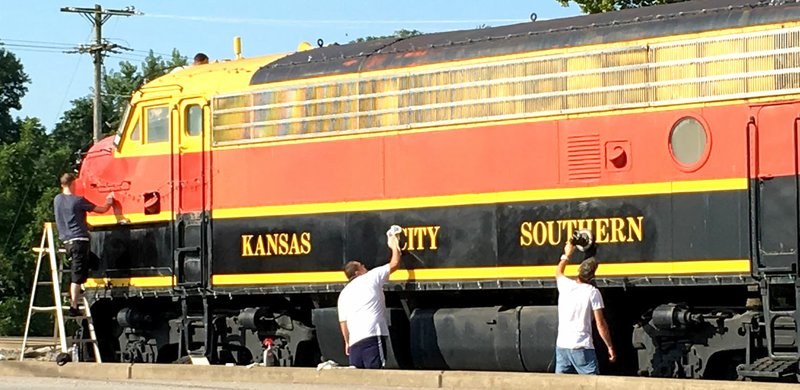DECATUR -- After nearly 25 years since being hoisted into place by a pair of heavy-lift cranes, Decatur's iconic EMD F7A locomotive and its companion bay window caboose #385 finally received a much-needed face-lift.
Armed with rotary buffers and lots of rubbing compound, a group of volunteers from DARP worked on both the locomotive and caboose for most of Aug. 17, removing dirt, grime and graffiti that had built up on the pair over the years. The end result was a bright finish that brought both locomotive and caboose back to life.
Over the next three Saturdays, the DARP volunteers will give KCS 73D and Caboose 385 several coats of wax to preserve the paint. Once complete, new numbers and KCS logos will be applied to brighten both railroad units, restoring them once again to the way they looked when they rolled through Decatur hauling freight and taking up the tail end of a train.
If you drive by the depot and train exhibits and see the volunteers working hard on this project, make sure to honk and wave to let them know you appreciate the work they are doing on these priceless pieces of railroad and Decatur history.
The pair's history
In 1991, Peterson Farms' founder and president, Lloyd Peterson, purchased both the F7 locomotive and caboose 385 from Kansas City Southern with the intent of putting the pair on display next to the 1910 Decatur Depot. Both engine and caboose were delivered to Peterson in Decatur on Sept. 17, 1991.
In June of 1993, after two years of restoration, the F7 known as Kansas City Southern unit number 73D and Caboose 385 made their final rail run from a spur line near Peterson feed mill to the depot via a Kansas City Southern grain train.
Waiting for the vintage railroad equipment's arrival was a pair of heavy-lift cranes. A crane was stationed on each end of the locomotive and later the caboose. The pair of cranes hoisted the 134,050-pound engine and 55,900-pound caboose to their final resting places on an old spur siding on the south end of the depot. Once the pair was in place, the 73D and 385 became symbols of Decatur which continue to today.
At 1 p.m. on Aug. 6, 1993, the locomotive, caboose and depot were formally dedicated and opened to the public and soon became a vital part of Decatur history. But the real history of both train and caboose start much further back, 69 years to be exact.
In August of 1950 KCS 73D was completed by the Electro-Motive Division (EMD) of General Motors in LaGrange, Ill. The unit's gigantic motor produced 1,500 horsepower and was capable of reaching speeds of between 85 and 100 miles per hour. It was fitted with a 1,200-gallon fuel tank (if you ever ask a train engineer how much fuel does it burn in an hour, you are likely to get a shrug as the engineer walks away).
It is 50-feet, 8-inches long, 9-feet, 10-inches wide, 15-feet high and weighs in at a whopping 234,300 pounds with the engine installed. Interestingly enough, KCS 73D still sports the same wheelbase that the first trains in England used, 4-feet, 61/2-inches.
Of the 2,261 F7As built, KCS 73D is one of less than 50 that remain.
Before it landed in its final resting place, 73D was an active locomotive for the Kansas City Southern Port Arthur, Texas, route that linked Kansas City, Mo., to the Texas Gulf Coast. Sulphur Springs, Gravette, Decatur, Gentry and Siloam Springs were all part of the route that eventually expanded on to New Orleans, La.
As its service life was winding down, KCS 73D was converted to a slug locomotive and renumbered to 1048 in the 1970s.
"Converting the locomotive to a slug involved removing the diesel engine while retaining all of the components for the electric traction motors. After the locomotive was converted to a slug, it would have been paired with another unit that retained its diesel engine, and the pair was usually referred to as a 'cow and calf' unit. Converting a locomotive to a slug and mating it with another unit was very useful to locomotives that ran in mountainous terrain. By spreading the horsepower over more axles, it delivered the same amount of horsepower while reducing the possibility of overheating the electric traction motors" (National Register of Historic Places Continuation Sheet).
Most people, when asked to visualize a caboose, will think of the iconic cupola style with an upper deck where the train crew often sat watching for hot breaks (smoke) or defective cars. But two examples of a different type of caboose can be seen in Gravette and Decatur, the bay window caboose.
KCS Caboose 385 was built by the Louisiana and Arkansas Railroad, a part of KCS, and was completed in June 1952. The caboose was built on a steel underframe with a wood-lined steel superstructure. The 33-inch diameter wheels were married to a pair of twin-axle (four wheels) trucks and equipped with both an air brake system as well as the old fashioned hand brake.
Like KCS 73D, caboose 385 was 50-feet, 8-inches, long and, like all rail cars and locomotives, sports the same 4-feet, 6 1/2-inch wheelbase. It is 11-feet, 31/2-inches wide, 13-feet, 3-inches in height and weighs in at 55,900 pounds.
Caboose 385 also served on the Kansas City to Port Arthur, New Orleans route until the downsizing of train crews from six to two in the 1980s. Replacing the caboose was a small electoral phonemic device equipped with a strobe light that marked the end of the train. These devices were nicknamed "Fred" or "one-eyed conductors." In 1985, KCS 385 was retired from service and purchased by Peterson a few years later.
General News on 08/28/2019

